Palliative Care Case Study: HIV Symptoms and Care Plan
VerifiedAdded on 2023/01/10
|9
|2421
|23
AI Summary
This case study explores the symptoms and care plan for a patient suffering from HIV. It discusses the socio-ecological framework and Corbin and Strauss Illness Trajectory model for evaluating the patient's needs.
Contribute Materials
Your contribution can guide someone’s learning journey. Share your
documents today.
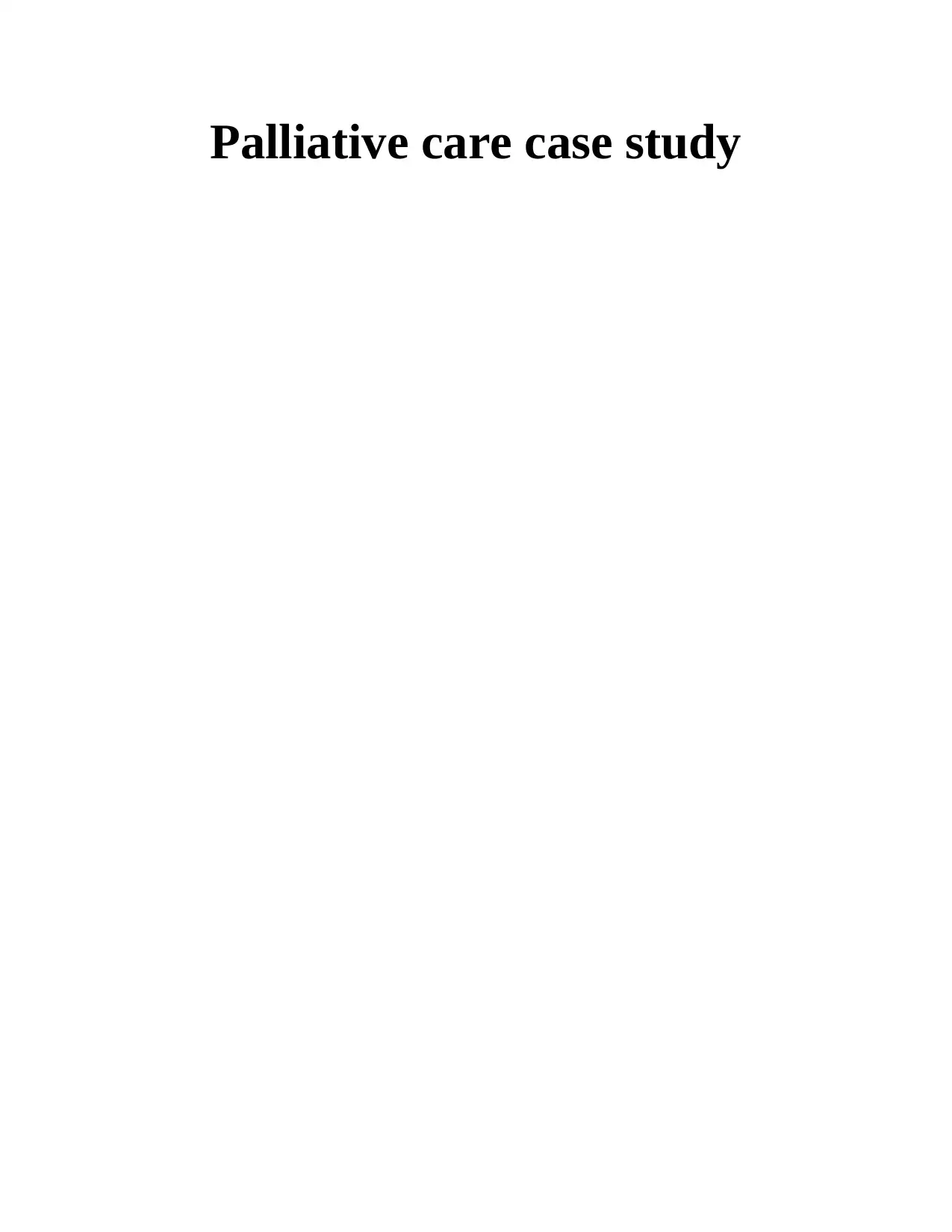
Palliative care case study
Secure Best Marks with AI Grader
Need help grading? Try our AI Grader for instant feedback on your assignments.

Table of Contents
Introduction......................................................................................................................................1
Main body........................................................................................................................................1
Conclusion.......................................................................................................................................5
References........................................................................................................................................6
Introduction......................................................................................................................................1
Main body........................................................................................................................................1
Conclusion.......................................................................................................................................5
References........................................................................................................................................6
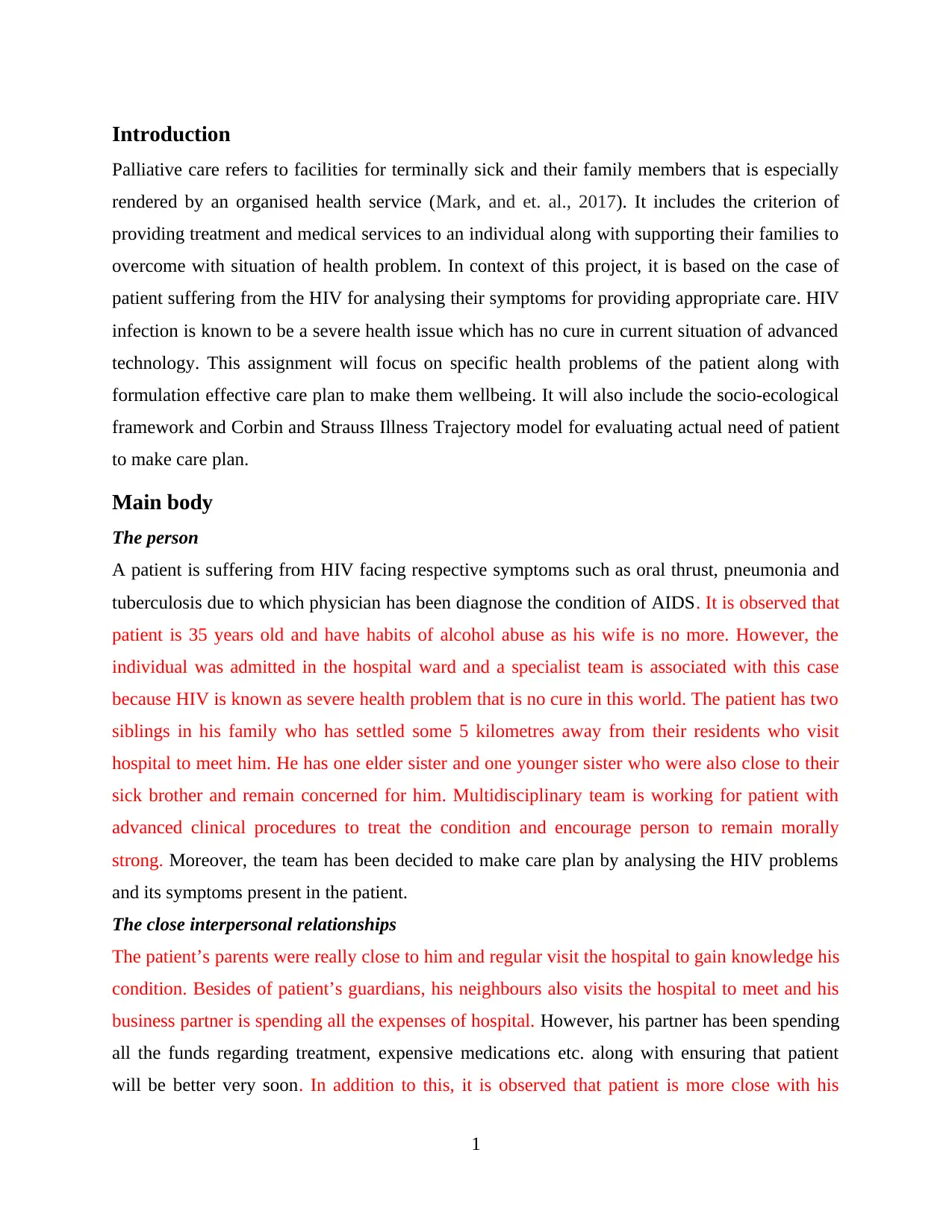
Introduction
Palliative care refers to facilities for terminally sick and their family members that is especially
rendered by an organised health service (Mark, and et. al., 2017). It includes the criterion of
providing treatment and medical services to an individual along with supporting their families to
overcome with situation of health problem. In context of this project, it is based on the case of
patient suffering from the HIV for analysing their symptoms for providing appropriate care. HIV
infection is known to be a severe health issue which has no cure in current situation of advanced
technology. This assignment will focus on specific health problems of the patient along with
formulation effective care plan to make them wellbeing. It will also include the socio-ecological
framework and Corbin and Strauss Illness Trajectory model for evaluating actual need of patient
to make care plan.
Main body
The person
A patient is suffering from HIV facing respective symptoms such as oral thrust, pneumonia and
tuberculosis due to which physician has been diagnose the condition of AIDS. It is observed that
patient is 35 years old and have habits of alcohol abuse as his wife is no more. However, the
individual was admitted in the hospital ward and a specialist team is associated with this case
because HIV is known as severe health problem that is no cure in this world. The patient has two
siblings in his family who has settled some 5 kilometres away from their residents who visit
hospital to meet him. He has one elder sister and one younger sister who were also close to their
sick brother and remain concerned for him. Multidisciplinary team is working for patient with
advanced clinical procedures to treat the condition and encourage person to remain morally
strong. Moreover, the team has been decided to make care plan by analysing the HIV problems
and its symptoms present in the patient.
The close interpersonal relationships
The patient’s parents were really close to him and regular visit the hospital to gain knowledge his
condition. Besides of patient’s guardians, his neighbours also visits the hospital to meet and his
business partner is spending all the expenses of hospital. However, his partner has been spending
all the funds regarding treatment, expensive medications etc. along with ensuring that patient
will be better very soon. In addition to this, it is observed that patient is more close with his
1
Palliative care refers to facilities for terminally sick and their family members that is especially
rendered by an organised health service (Mark, and et. al., 2017). It includes the criterion of
providing treatment and medical services to an individual along with supporting their families to
overcome with situation of health problem. In context of this project, it is based on the case of
patient suffering from the HIV for analysing their symptoms for providing appropriate care. HIV
infection is known to be a severe health issue which has no cure in current situation of advanced
technology. This assignment will focus on specific health problems of the patient along with
formulation effective care plan to make them wellbeing. It will also include the socio-ecological
framework and Corbin and Strauss Illness Trajectory model for evaluating actual need of patient
to make care plan.
Main body
The person
A patient is suffering from HIV facing respective symptoms such as oral thrust, pneumonia and
tuberculosis due to which physician has been diagnose the condition of AIDS. It is observed that
patient is 35 years old and have habits of alcohol abuse as his wife is no more. However, the
individual was admitted in the hospital ward and a specialist team is associated with this case
because HIV is known as severe health problem that is no cure in this world. The patient has two
siblings in his family who has settled some 5 kilometres away from their residents who visit
hospital to meet him. He has one elder sister and one younger sister who were also close to their
sick brother and remain concerned for him. Multidisciplinary team is working for patient with
advanced clinical procedures to treat the condition and encourage person to remain morally
strong. Moreover, the team has been decided to make care plan by analysing the HIV problems
and its symptoms present in the patient.
The close interpersonal relationships
The patient’s parents were really close to him and regular visit the hospital to gain knowledge his
condition. Besides of patient’s guardians, his neighbours also visits the hospital to meet and his
business partner is spending all the expenses of hospital. However, his partner has been spending
all the funds regarding treatment, expensive medications etc. along with ensuring that patient
will be better very soon. In addition to this, it is observed that patient is more close with his
1

mother then physicians suggests her presence nearby him for 24 * 7 hours. It is favourable for
achieving positive response of treatment from patient side and recovery speed can be increased.
Meanwhile, the patient demands to have his family with him to gain internal strength which is
required for recovery and become wellbeing.
The organisation
The staff of general hospital is required to use effective equipment’s and models to deliver
appropriate care which is explained here. Corbin and Strauss Illness Trajectory model is known
as a kind of nursing model which is generally applicable in condition in which patient was
suffering from chronic conditions. It includes the use of this model which is favourable in
chronic condition of health problems in order to deliver effective care and facilities for wellbeing
of an individual. Meanwhile, it involves the adoption of trajectory model of nursing in terms of
formulating appropriate care plan for delivering effective medications and treatment for patient
of HIV for improving their health condition (Vreeman, McCoy and Lee, 2017). There are several
benefits of trajectory model of nursing including its suitability for treating the chronic health
problems. It includes several chronic health issues such as diabetes, AIDS, cardiovascular
diseases and multiple sclerosis. However, the trajectory model of nursing is favourable to be
used for managing the condition of patient via formulating appropriate care plan. This model has
number of stages such as initial or pre-trajectory phase, trajectory onset phase, crisis phase, acute
phase, stable phase, unstable phase, downward phase and dying phase. It is necessary for care
professionals to follow its steps one by one in correct sequence which helps to provide
appropriate treatment to patient of HIV. It is helpful to establish effective care plan for them
which is given here.
The community – community networks/community support
Socio-ecological framework can be defined as a model that focus on relationship between
distribution of socially valued goods as well as culture. It has focus on number of factors to be
used while dealing with patient to provide appropriate care services including allocation,
distribution, culture and preferences. Basically, it is necessary for management in hospitals to
allot desired care professional and nursing staff to specific case kike who can handle critical
situation really well (McKinney and Marconi, 2016). It includes to appoint specialist doctors and
nurses who are capable to maintain morale strength of an individual and render support to
provide treatment effectively. However, it has been analysed the professionals associated in
2
achieving positive response of treatment from patient side and recovery speed can be increased.
Meanwhile, the patient demands to have his family with him to gain internal strength which is
required for recovery and become wellbeing.
The organisation
The staff of general hospital is required to use effective equipment’s and models to deliver
appropriate care which is explained here. Corbin and Strauss Illness Trajectory model is known
as a kind of nursing model which is generally applicable in condition in which patient was
suffering from chronic conditions. It includes the use of this model which is favourable in
chronic condition of health problems in order to deliver effective care and facilities for wellbeing
of an individual. Meanwhile, it involves the adoption of trajectory model of nursing in terms of
formulating appropriate care plan for delivering effective medications and treatment for patient
of HIV for improving their health condition (Vreeman, McCoy and Lee, 2017). There are several
benefits of trajectory model of nursing including its suitability for treating the chronic health
problems. It includes several chronic health issues such as diabetes, AIDS, cardiovascular
diseases and multiple sclerosis. However, the trajectory model of nursing is favourable to be
used for managing the condition of patient via formulating appropriate care plan. This model has
number of stages such as initial or pre-trajectory phase, trajectory onset phase, crisis phase, acute
phase, stable phase, unstable phase, downward phase and dying phase. It is necessary for care
professionals to follow its steps one by one in correct sequence which helps to provide
appropriate treatment to patient of HIV. It is helpful to establish effective care plan for them
which is given here.
The community – community networks/community support
Socio-ecological framework can be defined as a model that focus on relationship between
distribution of socially valued goods as well as culture. It has focus on number of factors to be
used while dealing with patient to provide appropriate care services including allocation,
distribution, culture and preferences. Basically, it is necessary for management in hospitals to
allot desired care professional and nursing staff to specific case kike who can handle critical
situation really well (McKinney and Marconi, 2016). It includes to appoint specialist doctors and
nurses who are capable to maintain morale strength of an individual and render support to
provide treatment effectively. However, it has been analysed the professionals associated in
2
Secure Best Marks with AI Grader
Need help grading? Try our AI Grader for instant feedback on your assignments.
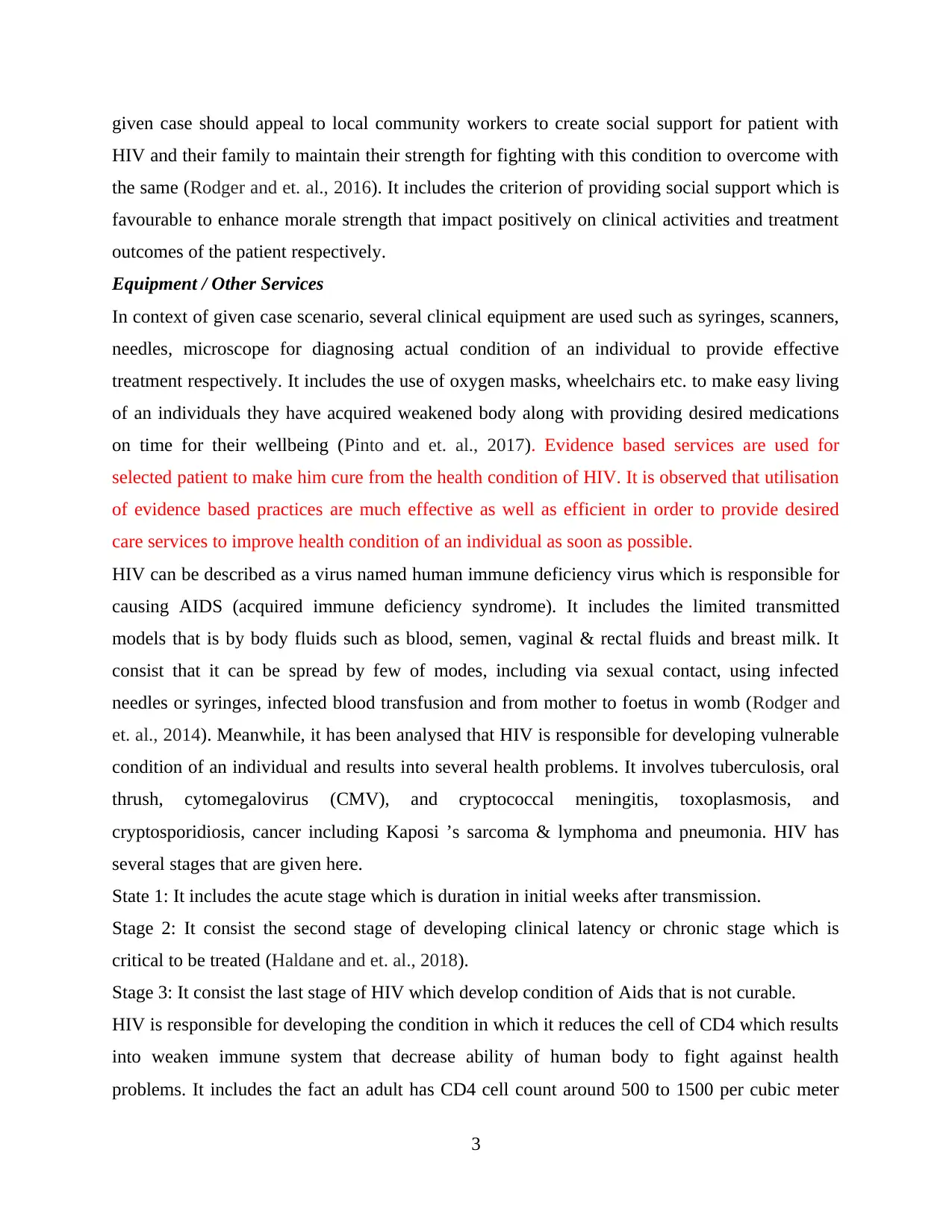
given case should appeal to local community workers to create social support for patient with
HIV and their family to maintain their strength for fighting with this condition to overcome with
the same (Rodger and et. al., 2016). It includes the criterion of providing social support which is
favourable to enhance morale strength that impact positively on clinical activities and treatment
outcomes of the patient respectively.
Equipment / Other Services
In context of given case scenario, several clinical equipment are used such as syringes, scanners,
needles, microscope for diagnosing actual condition of an individual to provide effective
treatment respectively. It includes the use of oxygen masks, wheelchairs etc. to make easy living
of an individuals they have acquired weakened body along with providing desired medications
on time for their wellbeing (Pinto and et. al., 2017). Evidence based services are used for
selected patient to make him cure from the health condition of HIV. It is observed that utilisation
of evidence based practices are much effective as well as efficient in order to provide desired
care services to improve health condition of an individual as soon as possible.
HIV can be described as a virus named human immune deficiency virus which is responsible for
causing AIDS (acquired immune deficiency syndrome). It includes the limited transmitted
models that is by body fluids such as blood, semen, vaginal & rectal fluids and breast milk. It
consist that it can be spread by few of modes, including via sexual contact, using infected
needles or syringes, infected blood transfusion and from mother to foetus in womb (Rodger and
et. al., 2014). Meanwhile, it has been analysed that HIV is responsible for developing vulnerable
condition of an individual and results into several health problems. It involves tuberculosis, oral
thrush, cytomegalovirus (CMV), and cryptococcal meningitis, toxoplasmosis, and
cryptosporidiosis, cancer including Kaposi ’s sarcoma & lymphoma and pneumonia. HIV has
several stages that are given here.
State 1: It includes the acute stage which is duration in initial weeks after transmission.
Stage 2: It consist the second stage of developing clinical latency or chronic stage which is
critical to be treated (Haldane and et. al., 2018).
Stage 3: It consist the last stage of HIV which develop condition of Aids that is not curable.
HIV is responsible for developing the condition in which it reduces the cell of CD4 which results
into weaken immune system that decrease ability of human body to fight against health
problems. It includes the fact an adult has CD4 cell count around 500 to 1500 per cubic meter
3
HIV and their family to maintain their strength for fighting with this condition to overcome with
the same (Rodger and et. al., 2016). It includes the criterion of providing social support which is
favourable to enhance morale strength that impact positively on clinical activities and treatment
outcomes of the patient respectively.
Equipment / Other Services
In context of given case scenario, several clinical equipment are used such as syringes, scanners,
needles, microscope for diagnosing actual condition of an individual to provide effective
treatment respectively. It includes the use of oxygen masks, wheelchairs etc. to make easy living
of an individuals they have acquired weakened body along with providing desired medications
on time for their wellbeing (Pinto and et. al., 2017). Evidence based services are used for
selected patient to make him cure from the health condition of HIV. It is observed that utilisation
of evidence based practices are much effective as well as efficient in order to provide desired
care services to improve health condition of an individual as soon as possible.
HIV can be described as a virus named human immune deficiency virus which is responsible for
causing AIDS (acquired immune deficiency syndrome). It includes the limited transmitted
models that is by body fluids such as blood, semen, vaginal & rectal fluids and breast milk. It
consist that it can be spread by few of modes, including via sexual contact, using infected
needles or syringes, infected blood transfusion and from mother to foetus in womb (Rodger and
et. al., 2014). Meanwhile, it has been analysed that HIV is responsible for developing vulnerable
condition of an individual and results into several health problems. It involves tuberculosis, oral
thrush, cytomegalovirus (CMV), and cryptococcal meningitis, toxoplasmosis, and
cryptosporidiosis, cancer including Kaposi ’s sarcoma & lymphoma and pneumonia. HIV has
several stages that are given here.
State 1: It includes the acute stage which is duration in initial weeks after transmission.
Stage 2: It consist the second stage of developing clinical latency or chronic stage which is
critical to be treated (Haldane and et. al., 2018).
Stage 3: It consist the last stage of HIV which develop condition of Aids that is not curable.
HIV is responsible for developing the condition in which it reduces the cell of CD4 which results
into weaken immune system that decrease ability of human body to fight against health
problems. It includes the fact an adult has CD4 cell count around 500 to 1500 per cubic meter
3
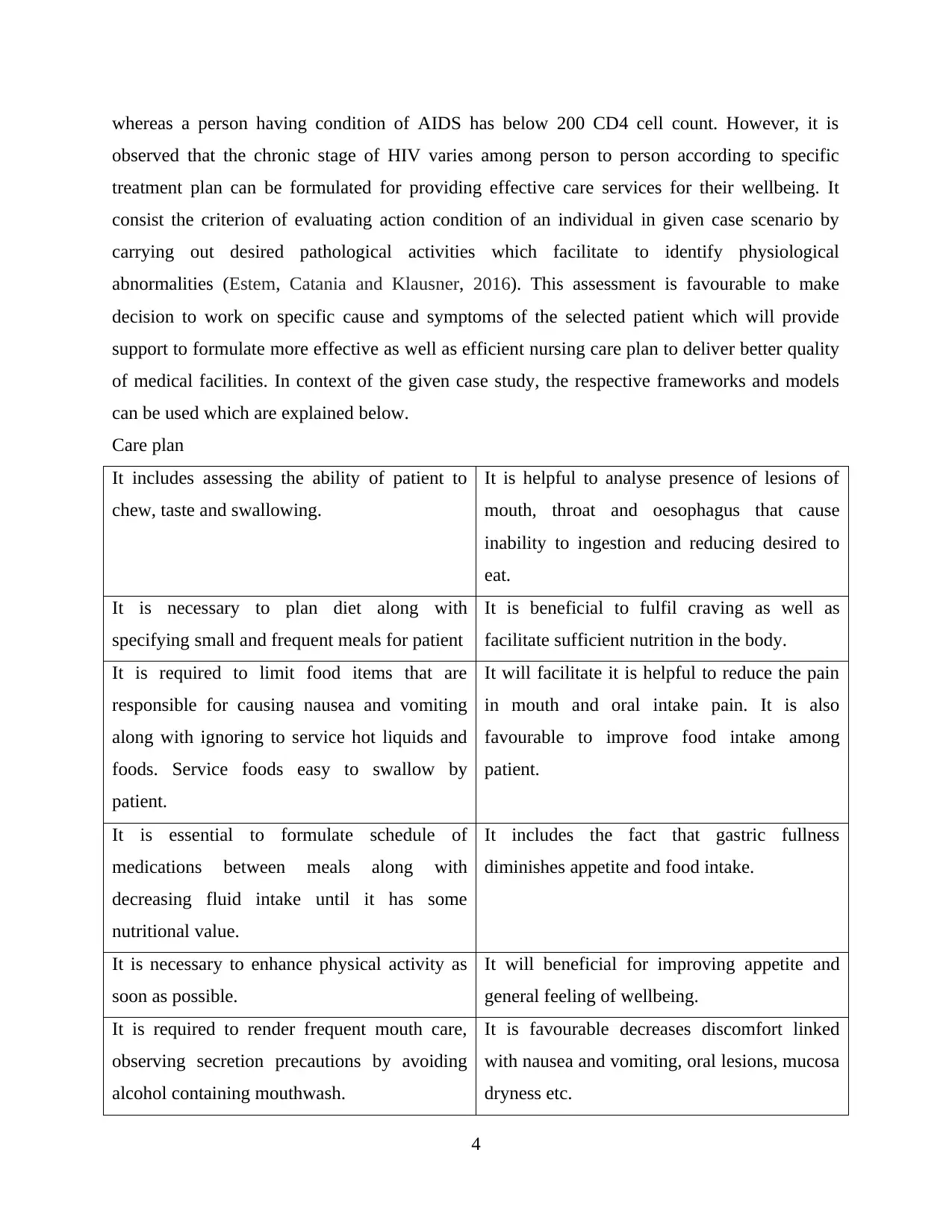
whereas a person having condition of AIDS has below 200 CD4 cell count. However, it is
observed that the chronic stage of HIV varies among person to person according to specific
treatment plan can be formulated for providing effective care services for their wellbeing. It
consist the criterion of evaluating action condition of an individual in given case scenario by
carrying out desired pathological activities which facilitate to identify physiological
abnormalities (Estem, Catania and Klausner, 2016). This assessment is favourable to make
decision to work on specific cause and symptoms of the selected patient which will provide
support to formulate more effective as well as efficient nursing care plan to deliver better quality
of medical facilities. In context of the given case study, the respective frameworks and models
can be used which are explained below.
Care plan
It includes assessing the ability of patient to
chew, taste and swallowing.
It is helpful to analyse presence of lesions of
mouth, throat and oesophagus that cause
inability to ingestion and reducing desired to
eat.
It is necessary to plan diet along with
specifying small and frequent meals for patient
It is beneficial to fulfil craving as well as
facilitate sufficient nutrition in the body.
It is required to limit food items that are
responsible for causing nausea and vomiting
along with ignoring to service hot liquids and
foods. Service foods easy to swallow by
patient.
It will facilitate it is helpful to reduce the pain
in mouth and oral intake pain. It is also
favourable to improve food intake among
patient.
It is essential to formulate schedule of
medications between meals along with
decreasing fluid intake until it has some
nutritional value.
It includes the fact that gastric fullness
diminishes appetite and food intake.
It is necessary to enhance physical activity as
soon as possible.
It will beneficial for improving appetite and
general feeling of wellbeing.
It is required to render frequent mouth care,
observing secretion precautions by avoiding
alcohol containing mouthwash.
It is favourable decreases discomfort linked
with nausea and vomiting, oral lesions, mucosa
dryness etc.
4
observed that the chronic stage of HIV varies among person to person according to specific
treatment plan can be formulated for providing effective care services for their wellbeing. It
consist the criterion of evaluating action condition of an individual in given case scenario by
carrying out desired pathological activities which facilitate to identify physiological
abnormalities (Estem, Catania and Klausner, 2016). This assessment is favourable to make
decision to work on specific cause and symptoms of the selected patient which will provide
support to formulate more effective as well as efficient nursing care plan to deliver better quality
of medical facilities. In context of the given case study, the respective frameworks and models
can be used which are explained below.
Care plan
It includes assessing the ability of patient to
chew, taste and swallowing.
It is helpful to analyse presence of lesions of
mouth, throat and oesophagus that cause
inability to ingestion and reducing desired to
eat.
It is necessary to plan diet along with
specifying small and frequent meals for patient
It is beneficial to fulfil craving as well as
facilitate sufficient nutrition in the body.
It is required to limit food items that are
responsible for causing nausea and vomiting
along with ignoring to service hot liquids and
foods. Service foods easy to swallow by
patient.
It will facilitate it is helpful to reduce the pain
in mouth and oral intake pain. It is also
favourable to improve food intake among
patient.
It is essential to formulate schedule of
medications between meals along with
decreasing fluid intake until it has some
nutritional value.
It includes the fact that gastric fullness
diminishes appetite and food intake.
It is necessary to enhance physical activity as
soon as possible.
It will beneficial for improving appetite and
general feeling of wellbeing.
It is required to render frequent mouth care,
observing secretion precautions by avoiding
alcohol containing mouthwash.
It is favourable decreases discomfort linked
with nausea and vomiting, oral lesions, mucosa
dryness etc.
4
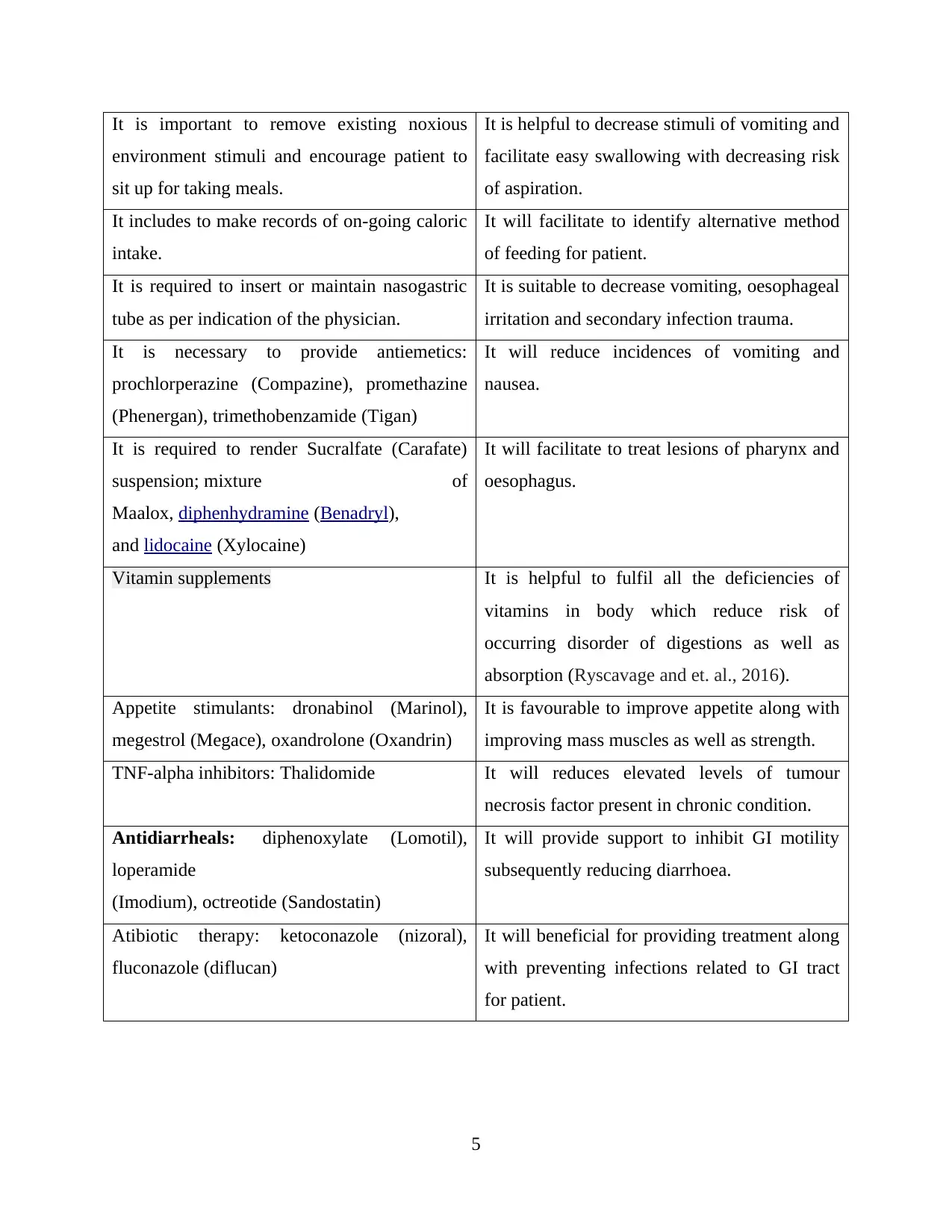
It is important to remove existing noxious
environment stimuli and encourage patient to
sit up for taking meals.
It is helpful to decrease stimuli of vomiting and
facilitate easy swallowing with decreasing risk
of aspiration.
It includes to make records of on-going caloric
intake.
It will facilitate to identify alternative method
of feeding for patient.
It is required to insert or maintain nasogastric
tube as per indication of the physician.
It is suitable to decrease vomiting, oesophageal
irritation and secondary infection trauma.
It is necessary to provide antiemetics:
prochlorperazine (Compazine), promethazine
(Phenergan), trimethobenzamide (Tigan)
It will reduce incidences of vomiting and
nausea.
It is required to render Sucralfate (Carafate)
suspension; mixture of
Maalox, diphenhydramine (Benadryl),
and lidocaine (Xylocaine)
It will facilitate to treat lesions of pharynx and
oesophagus.
Vitamin supplements It is helpful to fulfil all the deficiencies of
vitamins in body which reduce risk of
occurring disorder of digestions as well as
absorption (Ryscavage and et. al., 2016).
Appetite stimulants: dronabinol (Marinol),
megestrol (Megace), oxandrolone (Oxandrin)
It is favourable to improve appetite along with
improving mass muscles as well as strength.
TNF-alpha inhibitors: Thalidomide It will reduces elevated levels of tumour
necrosis factor present in chronic condition.
Antidiarrheals: diphenoxylate (Lomotil),
loperamide
(Imodium), octreotide (Sandostatin)
It will provide support to inhibit GI motility
subsequently reducing diarrhoea.
Atibiotic therapy: ketoconazole (nizoral),
fluconazole (diflucan)
It will beneficial for providing treatment along
with preventing infections related to GI tract
for patient.
5
environment stimuli and encourage patient to
sit up for taking meals.
It is helpful to decrease stimuli of vomiting and
facilitate easy swallowing with decreasing risk
of aspiration.
It includes to make records of on-going caloric
intake.
It will facilitate to identify alternative method
of feeding for patient.
It is required to insert or maintain nasogastric
tube as per indication of the physician.
It is suitable to decrease vomiting, oesophageal
irritation and secondary infection trauma.
It is necessary to provide antiemetics:
prochlorperazine (Compazine), promethazine
(Phenergan), trimethobenzamide (Tigan)
It will reduce incidences of vomiting and
nausea.
It is required to render Sucralfate (Carafate)
suspension; mixture of
Maalox, diphenhydramine (Benadryl),
and lidocaine (Xylocaine)
It will facilitate to treat lesions of pharynx and
oesophagus.
Vitamin supplements It is helpful to fulfil all the deficiencies of
vitamins in body which reduce risk of
occurring disorder of digestions as well as
absorption (Ryscavage and et. al., 2016).
Appetite stimulants: dronabinol (Marinol),
megestrol (Megace), oxandrolone (Oxandrin)
It is favourable to improve appetite along with
improving mass muscles as well as strength.
TNF-alpha inhibitors: Thalidomide It will reduces elevated levels of tumour
necrosis factor present in chronic condition.
Antidiarrheals: diphenoxylate (Lomotil),
loperamide
(Imodium), octreotide (Sandostatin)
It will provide support to inhibit GI motility
subsequently reducing diarrhoea.
Atibiotic therapy: ketoconazole (nizoral),
fluconazole (diflucan)
It will beneficial for providing treatment along
with preventing infections related to GI tract
for patient.
5
Paraphrase This Document
Need a fresh take? Get an instant paraphrase of this document with our AI Paraphraser
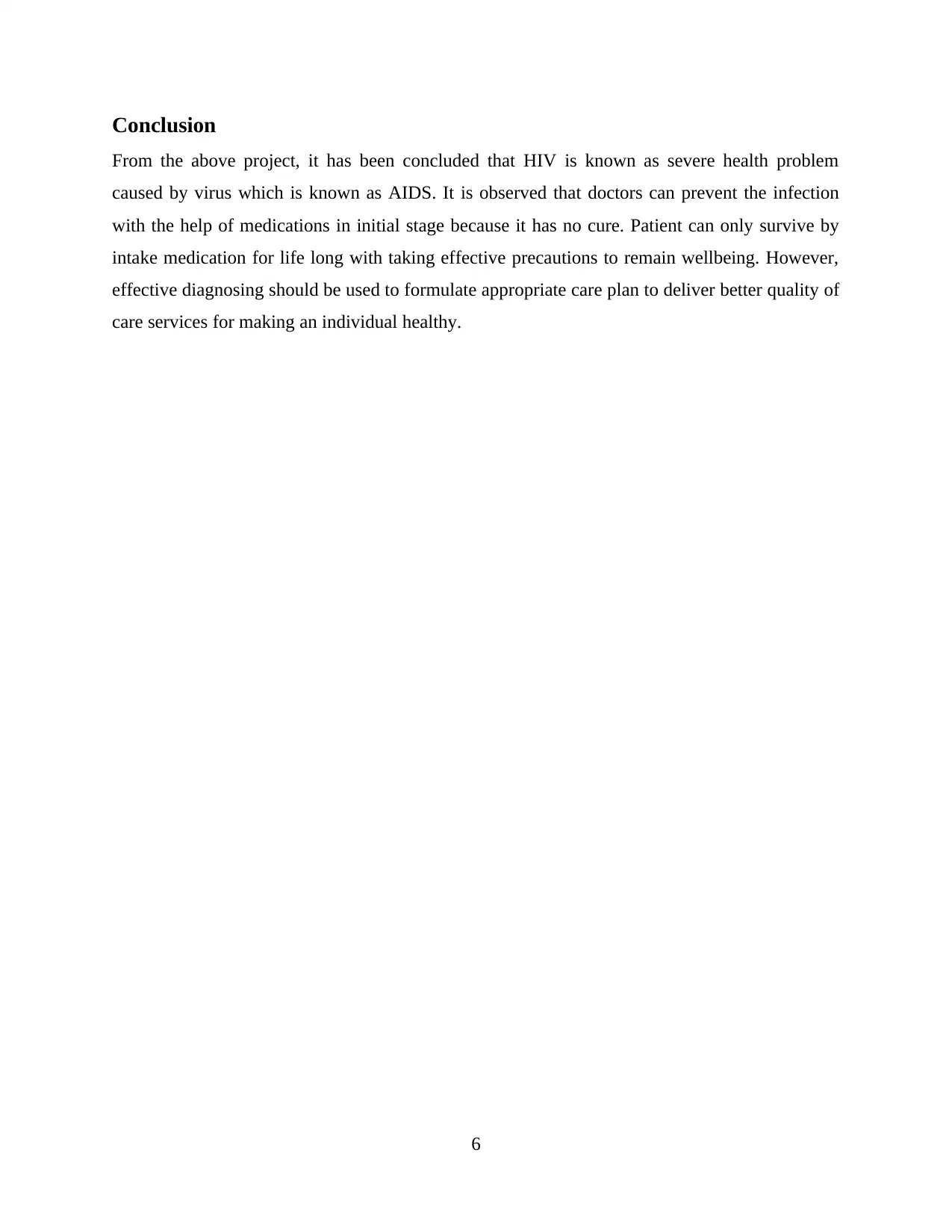
Conclusion
From the above project, it has been concluded that HIV is known as severe health problem
caused by virus which is known as AIDS. It is observed that doctors can prevent the infection
with the help of medications in initial stage because it has no cure. Patient can only survive by
intake medication for life long with taking effective precautions to remain wellbeing. However,
effective diagnosing should be used to formulate appropriate care plan to deliver better quality of
care services for making an individual healthy.
6
From the above project, it has been concluded that HIV is known as severe health problem
caused by virus which is known as AIDS. It is observed that doctors can prevent the infection
with the help of medications in initial stage because it has no cure. Patient can only survive by
intake medication for life long with taking effective precautions to remain wellbeing. However,
effective diagnosing should be used to formulate appropriate care plan to deliver better quality of
care services for making an individual healthy.
6
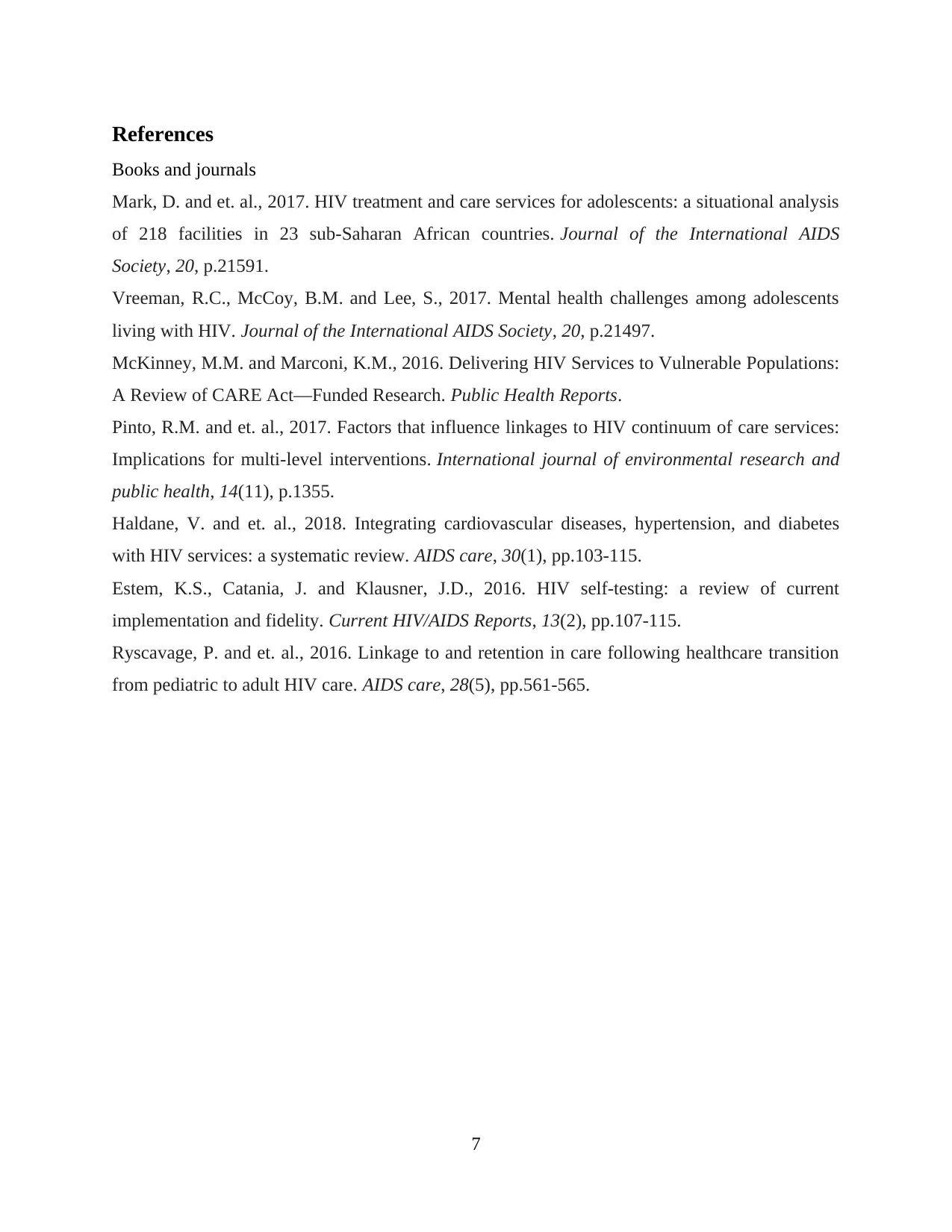
References
Books and journals
Mark, D. and et. al., 2017. HIV treatment and care services for adolescents: a situational analysis
of 218 facilities in 23 sub‐Saharan African countries. Journal of the International AIDS
Society, 20, p.21591.
Vreeman, R.C., McCoy, B.M. and Lee, S., 2017. Mental health challenges among adolescents
living with HIV. Journal of the International AIDS Society, 20, p.21497.
McKinney, M.M. and Marconi, K.M., 2016. Delivering HIV Services to Vulnerable Populations:
A Review of CARE Act—Funded Research. Public Health Reports.
Pinto, R.M. and et. al., 2017. Factors that influence linkages to HIV continuum of care services:
Implications for multi-level interventions. International journal of environmental research and
public health, 14(11), p.1355.
Haldane, V. and et. al., 2018. Integrating cardiovascular diseases, hypertension, and diabetes
with HIV services: a systematic review. AIDS care, 30(1), pp.103-115.
Estem, K.S., Catania, J. and Klausner, J.D., 2016. HIV self-testing: a review of current
implementation and fidelity. Current HIV/AIDS Reports, 13(2), pp.107-115.
Ryscavage, P. and et. al., 2016. Linkage to and retention in care following healthcare transition
from pediatric to adult HIV care. AIDS care, 28(5), pp.561-565.
7
Books and journals
Mark, D. and et. al., 2017. HIV treatment and care services for adolescents: a situational analysis
of 218 facilities in 23 sub‐Saharan African countries. Journal of the International AIDS
Society, 20, p.21591.
Vreeman, R.C., McCoy, B.M. and Lee, S., 2017. Mental health challenges among adolescents
living with HIV. Journal of the International AIDS Society, 20, p.21497.
McKinney, M.M. and Marconi, K.M., 2016. Delivering HIV Services to Vulnerable Populations:
A Review of CARE Act—Funded Research. Public Health Reports.
Pinto, R.M. and et. al., 2017. Factors that influence linkages to HIV continuum of care services:
Implications for multi-level interventions. International journal of environmental research and
public health, 14(11), p.1355.
Haldane, V. and et. al., 2018. Integrating cardiovascular diseases, hypertension, and diabetes
with HIV services: a systematic review. AIDS care, 30(1), pp.103-115.
Estem, K.S., Catania, J. and Klausner, J.D., 2016. HIV self-testing: a review of current
implementation and fidelity. Current HIV/AIDS Reports, 13(2), pp.107-115.
Ryscavage, P. and et. al., 2016. Linkage to and retention in care following healthcare transition
from pediatric to adult HIV care. AIDS care, 28(5), pp.561-565.
7
1 out of 9
Related Documents
Your All-in-One AI-Powered Toolkit for Academic Success.
+13062052269
info@desklib.com
Available 24*7 on WhatsApp / Email
![[object Object]](/_next/static/media/star-bottom.7253800d.svg)
Unlock your academic potential
© 2024 | Zucol Services PVT LTD | All rights reserved.





